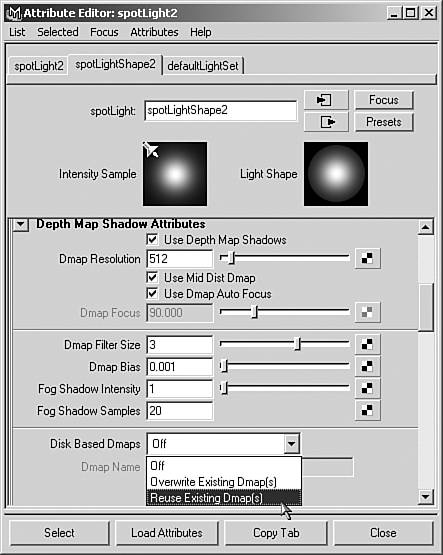Differences in Lighting
| Lighting types: Maya includes the same primary light types and shadow modes as max. One added light type that's unique to Maya is called Area light, a light source that enables you to use a rectangle- or square-shaped light source and cast soft light with penumbral shadows. This light type is invaluable for indoor scenes or any place you want soft lighting. Also, Maya's Ambient lights are somewhat like the Ambient control in max's Environment dialog box, in that this light can bring up lighting levels on all surfaces. However, Maya's Ambient lights act like Point lights that include an All Surfaces Lit variable. You can also cast shadows from Ambient lights and have multiple Ambient lights. The Volume light in Maya has nothing to do with volumetrics (dust cones) as you know them in max. Instead, this light type is simply a Point light with falloff that is visible and easy to control with the Scale tool. Creating lights: Lights are created just like objects, at a fixed size (1 working unit) and place (the origin point) when you choose Create | Lights | Light Type on the menu. You then position the light icon in your scene. You can scale light icons up and down without changing the rendered effect, except for the Area lights. An Area light's size is set by the icon itself, so you can use the Scale tool to stretch and size the Area light's rectangular panel. The Area light's shape affects how much light it emits. Creating shadows: Shadow modes in Maya and max are exactly the same mapped or raytraced shadows. As in max, mapped shadows are generally faster to calculate and look softer. Raytraced shadows are usually hard-edged, more appropriate with intense Point lights or sunlight. In Maya, you can set a radius for a raytraced shadow to soften the edge, but that causes a severe hit on rendering speed. A unique feature in Maya for mapped shadows (depth map shadows, in Maya's terminology) is the ability to reuse shadow maps (Dmaps; see Figure A.20), which makes rendering faster after you've rendered the shadow maps once. It even lets you edit the shadow map in an image editor. In max, shadow maps are always created on-the-fly and discarded after rendering for every frame. Another unique feature is that by default, Maya's Directional light (similar to max's Direct light) automatically adjusts to create shadows over all geometry, regardless of where the light icon is placed. Figure A.20. Reusing shadow maps in the Attribute Editor.
Light include/exclude: Maya uses a special window for light linking, as it's called in Maya. To open it, choose Window | Relationship Editor | Light Linking on the menu. There are two ways to view these light-object relationships: object-centric or light-centric. Grouping and assignment aids are included in the Light Sets section. All objects are lit by all lights by default, just as in 3ds max. |
EAN: 2147483647
Pages: 198
